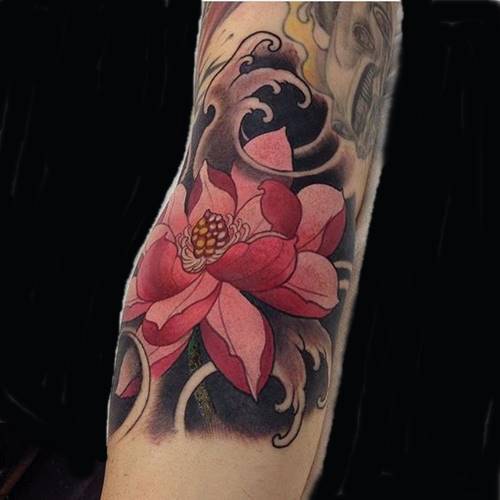The lower part of the Japanese Sleeve has been completed at last.
One of the main focus on this Japanese sleeve is The Koi fish has a deep and rich cultural significance in Japan. For centuries, these colorful fish have been celebrated for their beauty and symbolic meaning, and have become a popular motif in art, literature, and mythology. One of the most famous legends associated with the Koi fish is the story of the Dragon Gate.
According to the legend, the Koi fish had to swim upstream and climb the waterfall known as the Dragon Gate in order to reach the top of the mountain. This was no easy feat, as the journey was fraught with danger and obstacles. Many Koi fish would give up and turn back, but the strongest and most determined fish would persevere and eventually reach the top.
The Koi that successfully made it to the top of the Dragon Gate were said to be transformed into powerful dragons, capable of soaring through the sky and manipulating the elements. This transformation was seen as a symbol of perseverance, courage, and strength in the face of adversity

The story of the Dragon Gate has become a powerful symbol of success and achievement in Japanese culture, and has been used to inspire and motivate people to overcome challenges and reach their goals. It is also seen as a reminder that success often requires hard work and determination, and that the greatest rewards come to those who are willing to put in the effort and face their fears.

The Koi fish itself is also rich in symbolism in Japanese culture. It is often associated with good fortune, prosperity, and abundance, and is seen as a symbol of perseverance, strength, and endurance. The different colors of the Koi also have specific meanings. For example, the red Koi is associated with love and passion, while the black Koi is seen as a symbol of strength and overcoming obstacles.



In addition to its cultural significance, the Koi fish is also a popular ornamental fish in Japan. Many people keep Koi in outdoor ponds and gardens, and the fish are often featured in traditional Japanese art and architecture.
The Koi fish and its symbolism in Japanese culture is a rich and fascinating topic. The story of the Dragon Gate is just one example of the many legends and myths that have been associated with these beautiful fish over the centuries. Whether seen as a symbol of perseverance, strength, or good fortune, the Koi fish remains an important part of Japanese culture and a source of inspiration for many people.



The meaning of the lotus flower and what the different colors mean
The lotus flower is a symbol of purity, enlightenment, and rebirth that has been revered in many different cultures throughout history. In Eastern religions, such as Buddhism and Hinduism, the lotus flower holds particular significance as a representation of spiritual growth and awakening.
The lotus flower grows in muddy water, but emerges clean and pure, representing the potential for growth and enlightenment even in difficult circumstances. The lotus flower’s ability to rise above its surroundings and reach for the sun is seen as a metaphor for the human spirit’s journey towards self-realization.
The lotus flower also has different meanings depending on its color. Here are some of the most common interpretations:
- Pink Lotus: The pink lotus is the most popular and commonly seen lotus flower. It represents the highest level of enlightenment and is associated with the Buddha himself. Pink lotus flowers are often depicted in Buddhist art and literature, symbolizing the purity of the enlightened mind.
- White Lotus: The white lotus represents purity and spiritual perfection. It is often associated with the gods and goddesses of Eastern religions and is seen as a symbol of their divine presence.
- Red Lotus: The red lotus represents the heart and symbolizes love, compassion, and passion. It is often associated with the goddess Kuan Yin in Buddhism and is used to represent the fire of the heart’s desire.
- Blue Lotus: The blue lotus represents the victory of the spirit over the senses and is associated with the wisdom of the Buddha. It is often depicted in Buddhist art and literature as a symbol of the awakened mind.
- Yellow Lotus: The yellow lotus represents spiritual ascension, and is associated with the solar plexus chakra in Hinduism. It is said to help open the third eye and stimulate the intuition and psychic abilities.
In addition to its spiritual meanings, the lotus flower also has practical applications. Its seeds can be eaten and are used in traditional medicine for their nutritional and healing properties. The leaves and flowers are used to make teas and tinctures that are said to have a calming effect on the body and mind.
The lotus flower is a powerful symbol of spiritual growth, enlightenment, and rebirth. Its various colors represent different aspects of the human spirit and are seen as a reminder of our potential for growth and transformation, even in difficult circumstances. The lotus flower’s timeless symbolism has made it an enduring symbol of hope, inspiration, and inner strength for countless generations.
Cherry Blossoms: A Symbolic Reminder of the Transience and Beauty of Life in Japanese Culture



Cherry blossoms, or “sakura” in Japanese, are an iconic symbol of Japanese culture and hold a special meaning for the Japanese people. These delicate pink flowers bloom in early spring, covering the country with a blanket of soft pink hues and bringing joy and beauty to all who see them.
In Japanese culture, cherry blossoms are a symbol of renewal, hope, and the fleeting nature of life. They remind us to appreciate the beauty of the present moment and to cherish the time we have with our loved ones. The cherry blossom season, known as “Hanami,” is a time of celebration and reflection, where people gather with friends and family to admire the beauty of the flowers and enjoy picnics under the blooming trees.

The cherry blossom is also a popular motif in Japanese art, literature, and fashion, appearing in everything from traditional paintings and kimono fabrics to modern pop culture. Its delicate petals and ephemeral beauty have inspired countless works of art and poetry, symbolizing the transience of life and the beauty of impermanence.
In addition to its cultural and aesthetic significance, the cherry blossom also has practical uses in traditional Japanese medicine and cuisine. Its blossoms and leaves are used to make teas, sweets, and various herbal remedies, known for their health benefits and delicious flavors.
Overall, cherry blossoms hold a special place in Japanese culture, representing the beauty, fragility, and impermanence of life. They serve as a reminder to appreciate the present moment and to find joy and beauty in the fleeting nature of our existence.
The process of creating a Japanese sleeve tattoo starts with the initial line work.
The process of creating a dragon tattoo involves the application of blackwork and shading.


